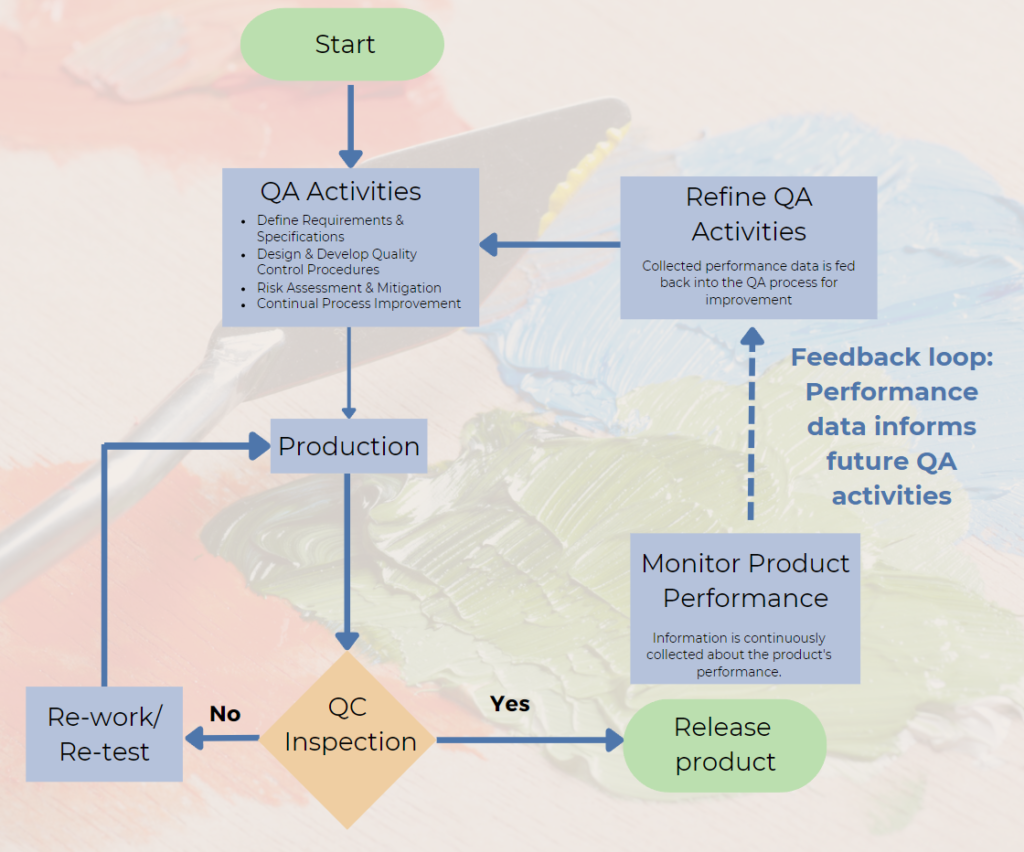Demystifying Quality Assurance (QA)
The world relies on countless products to function smoothly. Years ago, I was a research and development chemist in a laboratory producing web offset inks for the newspaper industry. I am going to use this experience as an illustrative example to showcase the concepts of Quality Control (QC), Quality Assurance (QA), and Questions and Answers (Q&A), which often leads to confusion among individuals.
Quality Control: Ensuring Consistent Ink Products
Imagine a factory producing web offset inks for newspaper printing presses. QC is the inspector who ensures each batch of ink meets the specified requirements. The ink needs specific properties for optimal printing. The QC inspector checks incoming raw materials e.g., pigments and binders, against defined specifications. They also test the finished ink for factors like colour, consistency, viscosity (thickness), and drying time. These tests use precise tools and follow established procedures to identify any deviations from the acceptable ranges (tolerance levels).
Quality Assurance: The Strategist Behind High-Quality Ink
QA takes a broader view. They are the strategists who define the ink specifications in the first place. QA encompasses the entire ink creation process, from selecting the right raw materials to monitoring the production line and even post-production performance of the ink in printing presses. They ensure processes are in place to prevent defects before they happen, unlike QC which identifies them after the fact.
Think of QA as the recipe developer who ensures the ink has the right ingredients and production methods, while QC is the inspector who verifies each batch tastes good and meets the recipe’s specifications.
The QA Conundrum: Beyond Questions and Answers (Q&A)
The world of quality can be confusing, especially when acronyms fly around. One common misconception is that QA stands for “Question and Answer.” QA in quality assurance operates in a more proactive space, much like ensuring a consistent, high-quality ink for printing presses.
Imagine you’re a newspaper printing press operator, and you need consistent, vibrant ink to deliver clear images day in and day out. QA would not be about waiting for complaints about blurry print (demanding questions and answers – Q&A). Instead, QA would be the silent hero behind the scenes, making sure the ink meets the press’s needs:
- Sourcing high-quality ingredients: QA would ensure raw materials like pigments and binders meet defined specifications.
- Developing the perfect formula: They would define the ideal ink composition for consistent colour, viscosity (thickness), and drying time – the recipe for perfectly printed newspapers.
- Standardising the mixing process: QA would establish standardised procedures to maintain consistent ink properties throughout production.
- Regularly testing the final product: QA would not wait for the presses to jam or produce dull prints. They would perform regular checks on the ink itself, ensuring it meets the press’s requirements and delivers the desired outcome.
By focusing on these steps throughout the ink creation process, QA prevents problems before they arise. This ensures a steady flow of high-quality ink, leading to crisp, vibrant newspapers.
Here’s a table to illustrate the key differences:
| Feature | Quality Control (QC) | Quality Assurance (QA) |
| Focus | Identifying defects in the final product | Preventing defects throughout the process |
| Timing | During or after production | Throughout the entire development lifecycle |
| Activities | Inspections, measurements, testing | Process improvement, risk assessment, audits |
Alternatively, here’s a flowchart of activities and the relationship between QC and QA.

QA’s role extends far beyond physical products. Its focus on preventing defects and ensuring consistent quality is vital across numerous industries:
- Cybersecurity: QA helps design and implement secure systems, penetration test for vulnerabilities, and ensure software updates maintain security protocols.
- Defence: From rigorously testing military equipment to overseeing the quality of materials used in aircraft construction, QA plays a critical role in national security.
- Construction: QA engineers ensure buildings meet architectural plans and safety codes. They conduct inspections throughout the construction process and perform tests on materials like concrete and steel.
- Manufacturing: QA specialists develop and implement quality control procedures for production lines, ensuring consistent quality in everything from automobiles to medical devices.
- Food and Beverage: From farm-to-table, QA protocols ensure food safety and consistent quality in ingredients, processing, and packaging.
- Pharmaceuticals: Rigorous QA testing throughout drug development is essential to ensure the safety and efficacy of medications.
This is just a glimpse into the diverse applications of QA. Wherever consistent quality and safety are paramount, you will find QA professionals working behind the scenes to ensure excellence.

